For this week’s post, I am in Cheapside in 1986, looking across to the shop of Shirt Makers L&R Wooderson, on the corner of Wood Street:

Thirty five years later and the building is still there, however L&R Wooderson have now been replaced by a card shop, Cards Galore:
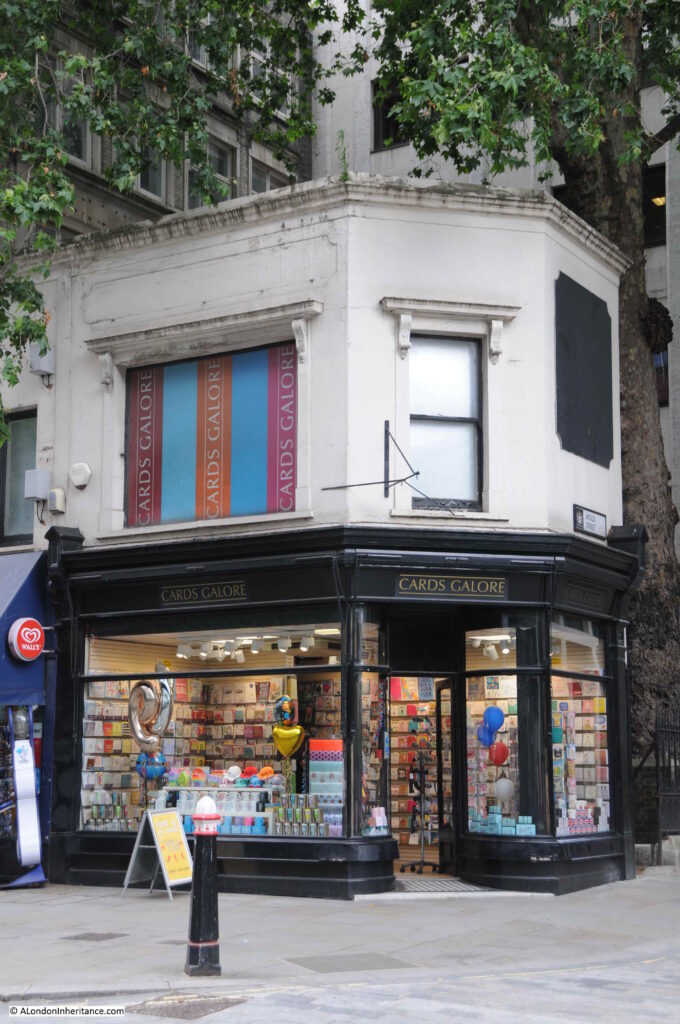
A wider view, showing Wood Street leading off Cheapside to the right:
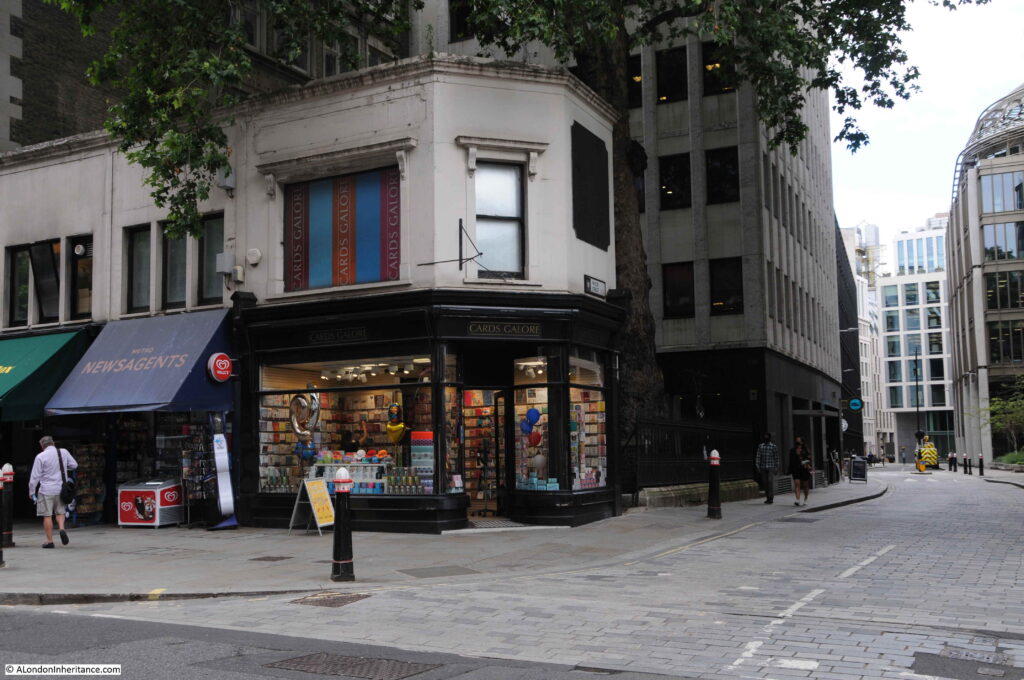
The location is shown in the map below, by the red circle. For reference, part of St. Paul’s Cathedral can be seen to the left (Map © OpenStreetMap contributors):

There is much to discover in this small, corner plot of land, part of which has a large tree which towers over the top of the shop, and can just be seen in the above photos.
The tree has been a significant landmark on Cheapside for very many years, and it was mentioned frequently in newspapers throughout the 19th century, for example in the following from the London Sun, when on the 1st April 1846 the paper reported:
“A ROOKERY IN CHEAPSIDE AND A CHERRY TREE ON LONDON BRIDGE – It is a singular fact that at the present times there are two crows’ nests on a lofty tree at the corner of Wood street, Cheapside; the birds are mated. One day last week, a furious fight took place between the four of them, which ended in the partial demolition of one of the nests. The damage has been since repaired. On the City end of London bridge a cherry tree, growing from one of the chinks in the granite, is now putting forth leaves. It is almost three years old.”
The tree appears to have been under threat in 1881, when multiple newspapers carried the following report:
THE CHEAPSIDE TREE – A flagrant act of arboricide is about to be perpetuated of malice aforethought and in open day. If there is one tree in London the position of which, apart from all personal charms and apart from the rest due to venerable age, deserves to be saved from the innovating axe, it is ‘the Cheapside tree’. For generations its pretty group of foliage has peeped out as a surprise and contrast to the surrounding masses of stone and brick. It has been a standing emblem to thousands of fagged and dust-stained city clerks of their annual fortnight holiday. It is blessed amongst trees. A tree of the street is infinitely more precious than ‘a tree of the field’. But it is doomed, and bad luck to the ruthless contractor or avaricious land-jobber by whose instigation the Cheapside tree is to be laid low.”
The tree did survive, no doubt helped by the number of references to the possible destruction of the tree in newspapers using such graphical descriptions as in the above report.
The tree was also used in adverts and references to shops and businesses in the immediate vicinity of the tree, adding the tree to their location to help potential customers find their business. L&R Wooderson were also using the tree as a reference in the 1986 photo, as shown by the following extract from the photo of the shop door:
The term “Under the Tree” was used by a number of businesses operating in the terrace of buildings of which L&R Wooderson is part, for example:
- Illustrated London News: 13th August 1853 – Rowe’s 25,000 Cab-Fares to and from all the Railways, Public Buildings, &c in London. Samuel Row, Under the Tree, Cheapside
- Kentish Mercury: 31st January 1890 – The Express Dairy Company’s new branch at 130, Wood Street, Under the Tree, Cheapside is now Open for Business
- The Bystander: 2nd August 1905 – For Gentlemen, the H.W. Velvet Grip Boston Garter. The Acme of Comfort, the Height of Perfection. L&R Wooderson, Under the Tree, 122/4, Cheapside, E.C.
It is difficult to determine the age of the tree. It is a London Plane tree, and the Woodland Trust define the tree as a cross between the Oriental plane and the American sycamore. They also state that the tree was first noticed in London in the mid 17th century, and that planting across London started in the late 18th century, so the tree probably dates from at least the late 1700s and must be around 250 years old.
A view of the tree from Wood Street, looking back towards Cheapside shows the impressive height and spread of the tree:

The tree also featured in the following photo from the book Wonderful London by St John Adcock, from the first decades of the 20th century:
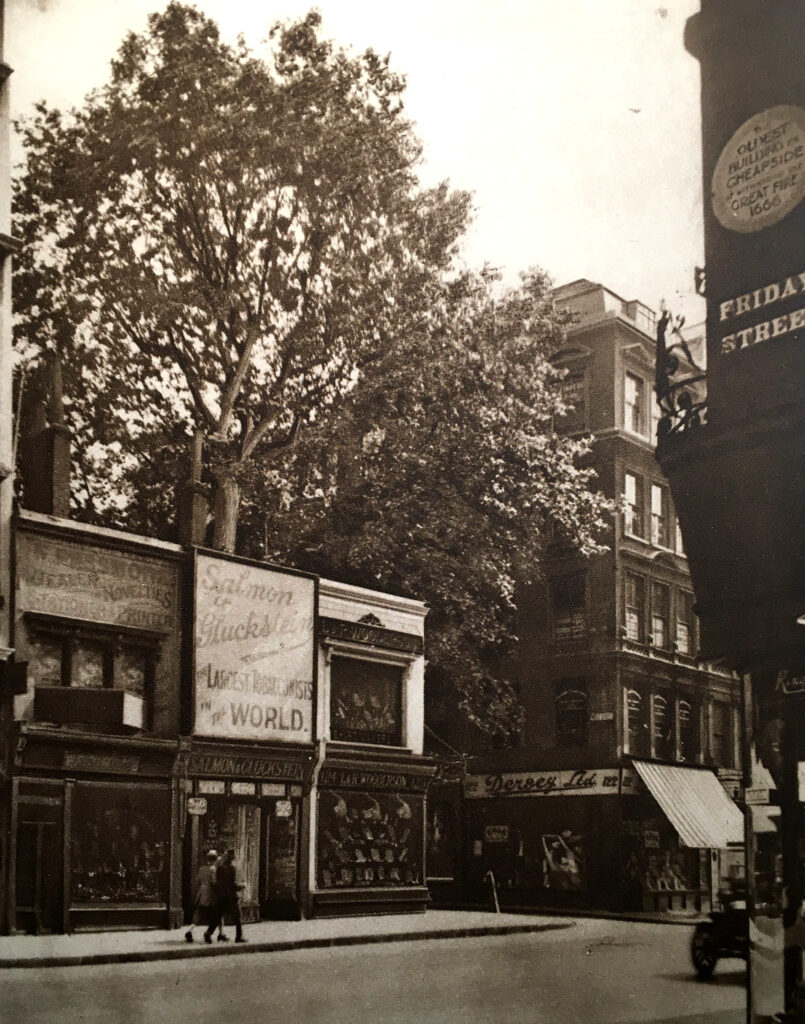
The shop of L&R Wooderson is also in the above photo, looking much the same as it would many years later in 1986. Friday Street, and the plaque on the right of the above photo will be the subject of a future post.
The first written reference I can find to L&R Wooderson is an advert in the Daily Telegraph and Courier on the 27th September 1899 for:
“HOSIERS – Improver WANTED – apply personally or by letter, L.R. Wooderson, 45, Eastcheap, E.C.”
However whilst the name is correct, in 1899 their address was at the eastern end of Eastcheap, towards Great Tower Street. The 1895 Post Office Directory confirms their original Eastcheap address and gives their full names as Llewellyn and Robert Wooderson.
This is where researching these posts always leads me down different routes, as having their full names, I wanted to know a bit more about them.
Searching the census records resulted in a bit of a mystery. The 1881 census records Llewellyn and Robert Wooderson living at 47 Lester Square, St Anne Soho (the parish).
I am not aware that there was a Lester Square, or that Leicester Square was originally called Lester Square, and could not believe there was an error in the census data. Reading through the census entries for 1881 there is also a St John’s Hospital at 45 Lester Square. There was indeed a St John’s Hospital for Diseases of the Skin at number 45 Leicester Square from 1865 to 1867, which confirmed that the spelling of the square was wrong in the 1881 census.
In 1881, Llewellyn and Robert Wooderson were part of a large family at number 47 Leicester Square, which consisted of:

Llewellyn and Robert were aged 8 and 6 in 1881, and whilst the rest of the children were born in London, Robert is recorded as being born in Canada.
Their father, Henry Wooderson is listed as a Fruit Salesman, as is the eldest of the sons, also a Henry, however although son Henry has the same first name as his listed father, he cannot have been his biological father.
There is a 12 year age difference between Henry (28) and his wife Sarah (40), and if Henry had fathered the younger Henry, he would have been 11 at the time, so possibly Henry, George and Edwin are the sons of a previous marriage of Sarah’s with Llewellyn and Robert possibly being Henry’s biological sons.
The two Henry’s worked in Covent Garden market as a Henry Wooderson & Sons is listed in the 1913 book “Covent Garden, Its Romance and History” by Reginald Jacobs. The younger son George may well have gone into the same business as a George Wooderson is listed as having a shop in the north row of shops at Covent Garden.
By the 1891 census, the father Henry could possibly have died as there is no mention of him in the census. The eldest son Henry was now married to Harriet and they were living in Tavistock Street. Llewellyn who was now 18 and Robert, 16, were living with them. By 1891 they had started in the profession that would result in their shop in Cheapside as their were both listed as Hosiers Assistant, and not long after they would open their first shop in Eastcheap.
By 1901, Llewellyn had joined the commuting class having moved out to Somerset Road in Reigate, to a terrace house which is still there. Married to Alice, and with two sons Llewellyn (2) and Malcolm (0). The business must have been doing reasonably well as also living in the house was a domestic servant
In the 1911 census, Robert Wooderson was married to Nellie Geraldine and had two sons. In the 1881 census, Robert was listed as being born in Canada, however the 1911 census adds the city of Toronto. It would be fascinating to understand why, of all the family members, only Robert was born in Canada, and what his mother was doing in the country at the time.
Also in 1911, Robert was listed as a Gentlemens Hosier, and he was living along with his family in Lessar Avenue, Clapham. His house is still in the street.
By the 1939 Register, Robert had moved to Atkins Road, Wandsworth, and his son Thomas was aged 40, single and listed as a Master Hosier so had probably joined the family business in Cheapside. Robert would die in 1957.
I cannot find any reference to Llewellyn’s later life.
They also seem to have had the two shops, the original on Eastcheap, and the shop featured in the photos at the start of the post on the corner of Cheapside and Wood Street. It would have been fascinating to try and find out more about their life, however I am always constrained by time within the scope of a weekly post.
Behind the old L&R Wooderson shop, and where the tree is located is a small patch of open ground facing Wood Street:

This was the churchyard of the church of St Peter West Cheape. The churchyard can be seen in the following extract from Rocque’s 1746 map, on the left, above the “C” of Cheapside:
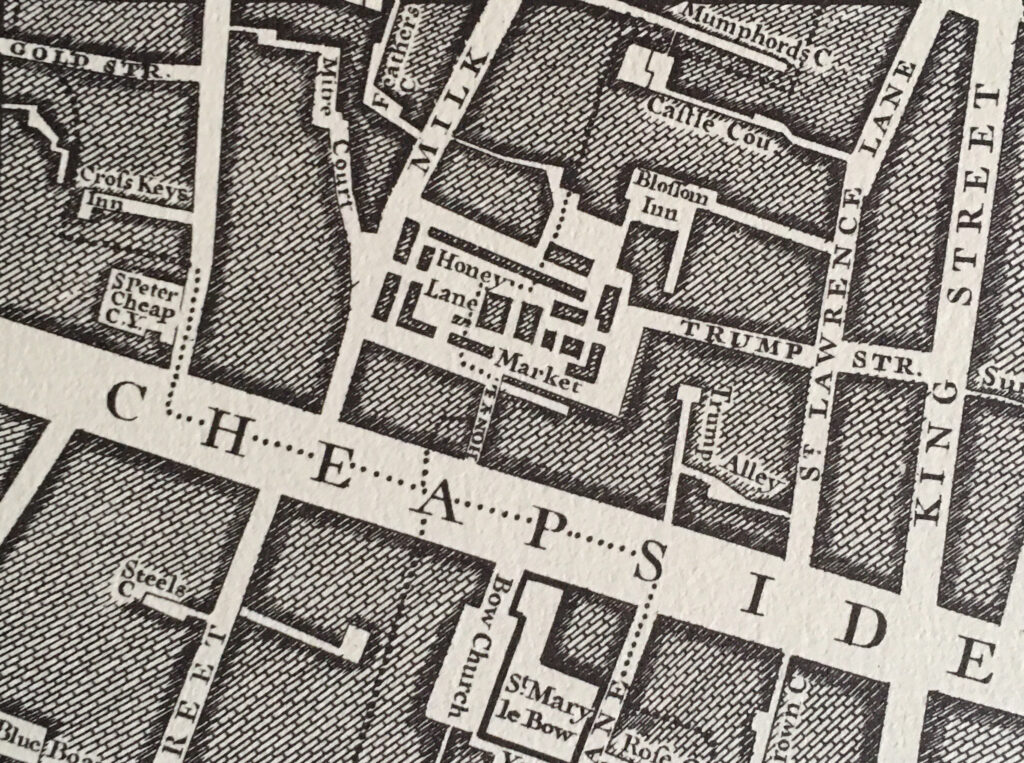
In the above map of 1746, a row of buildings is shown between the churchyard and Cheapside, following the line of buildings that we see today, however in the earlier 1682 map by William Morgan, the churchyard (above the E and A of Cheap) is an open space up to the edge of Cheapside:

The appearance of the buildings, of which L&R Wooderson was a part, gives the impression of being of some age, however there is no (that I can find) confirmed dating of the terrace, however they do follow the alignment shown in the 1746 map, so they do follow the property boundaries of the post Great Fire rebuild.
The church that once occupied the space, along with its churchyard, was one of the churches lost in the 1666 Great Fire, and not rebuilt.
In the book “London Churches Before The Great Fire” by Wilberforce Jenkins (1917), the old church was described:
“The ‘Church of St Peter, West Chepe, stood on the corner of Wood Street, Cheapside, and was not rebuilt after the Fire. The well-known tree in Cheapside marks the spot, and a small piece of the churchyard remains. It was sometimes called St Peter-at-Cross, being opposite the famous Cross which stood in the middle of the street, and was at one time an object of pride and veneration, and at a later period the object of execration and many riots, until pulled down and burnt by the mob. The date of the ancient church is uncertain, but there would appear to be a reference to it in 1231. In the ‘Liber Albus’, one Geoffrey Russel is mentioned as having been present when a certain Ralph Wryvefuntaines was stabbed in the churchyard of St Paul’s and being afraid of being accused, fled for sanctuary to the Church of St Peter.
Thomas Wood, goldsmith and sheriff, is credited with having, in 1491, restored or rebuilt the roof of the middle aisle, the structure being supported by figures of woodmen. Hence, so tradition says, came the name of the street, Wood Street.”
The “famous Cross” mentioned in the above extract was one the crosses erected by Edward I in 1290 on the corner of Wood Street, to mark the resting places of Queen Eleanor’s coffin on its way from Lincoln to Westminster Abbey.
The cross was a large structure and was decorated with religious iconography including images of the Pope and the Virgin. From the mid 16th century onwards, the cross was the subject of attack by puritans who objected to the religious symbols on the cross.
On the 2nd of May, 1643, the cross was demolished, which was illustrated in the following print produced by Wenceslaus Hollar in the same year (© The Trustees of the British Museum):

The illustration at the bottom of the print shows the “Booke of Sportes upon the Lords Day” being burnt on the site of the cross.
The Book of Sports was a book first published in 1617 during the reign of James I to define what sports were allowed on a Sunday. Initially only covering Lancashire to try and resolve a dispute between Puritans and mainly Catholic gentry, the guidance within the book was applied across the whole country in the following year.
Republished by Charles I, the book was a constant problem for Puritans who considered any playing of sport on a Sunday against their religious principles. As the influence of Puritanism grew in the lead up to the English Civil War, Parliament ordered that the book be publically burnt, one of the burnings was on the site of the cross, on the 10th May 1643.
The old churchyard of St Peter, West Chepe is now a small open space with a small number of gravestones. In the following photo, the brick rear of the building on Cheapside, including the old shop of L&R Wooderson is shown on the left:

Some of the graves are from the early 19th century showing that while the church was not rebuilt after the Great Fire, the churchyard continued in use.
Side gate between the buildings facing Cheapside and the graveyard:

On the railings facing onto Wood Street is an image of St Peter, along with the cross keys frequently shown with St Peter as the “keys to heaven”.
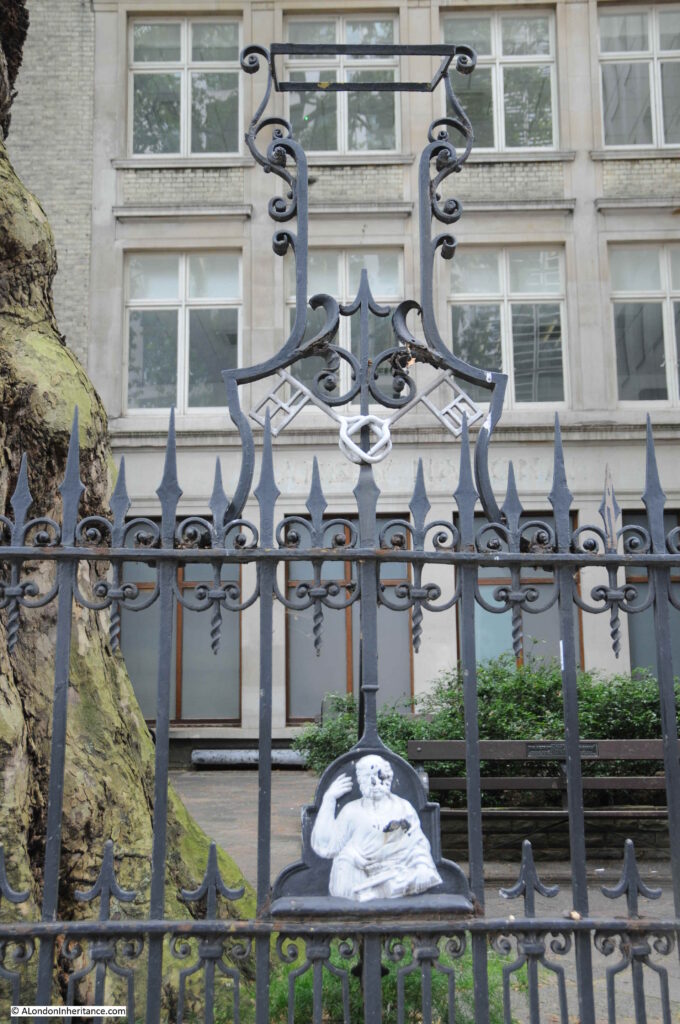
And on the rear of the image of St Peter, is the date 1712 and the names of the churchwardens, which appears to date the railing to 1712:

I would have liked to have had the time to find out more about the Wooderson family. For how long the family was involved with the shop and when it finally closed. Cards Galore who currently occupy the shop seem to have been expanding during the 1990s, however I cannot find their Cheapside shop listed during this decade, so perhaps it was in the 2000’s that L&R Wooderson finally closed.
This has been an incredibly interesting corner of Cheapside, tracing the family of the shop, a church destroyed during the Great Fire and the Cheapside Cross destroyed in the years leading up to the English Civil war, however as usual, I am just scratching the surface.


Another fascinating article, thank you, with an invitation to those interested in family history: Llewellyn Wooderson and his wife had 2 more sons before emigrating to New Zealand, where Llewellyn died in 1947. Their eldest son, Llewellyn Charles, became a farmer and his wife, Joyce, died in 2004 at the age of 103.
I worked in the city from 1969 – 1987. 12 years of which in Princes Street. I walked by that shop 100s of times (probably 1000s as I spent most lunchtimes on cheap side!). It was so distinctive. I remember it well. Thx for the post v interesting as ever.
Sadly, Cards Galore closed its doors a couple of weeks ago, presumably because the City has not been adequately repopulated.
One of the three shops in that row was a florist in the 1950s. Madeleine Gal (Mrs Robert Henrey) describes a morning she spent helping out there in her book, The Virgin of Aldermanbury (recommended and easily obtainable).
Fantastic post. I love your blog.
Interesting to mention the hospital in Leicester Square, St John`s hospital for Diseases of the skin.
I attended this hospital in 1978 after the birth of my daughter and was diagnosed with allergic dermatitis.
I assume the hospital is now long gone.
The dermatology outpatient department moved to St Thomas’ hospital in 1989, but the Dutch-gabled building is still there off Leicester Square.
It’s at 5 Lisle Street, now repurposed as a Slug and Lettuce pub.
Clearly visible on G***** street view if you look north on Leicester Street.
I always rather liked the plaque on the wall from 1687 on the back of the buildings.
Henry Thomas Wooderson was born January 1842 in Marylebone, London, so I think we can presume he is the father of all the Wooderson children, his wife was Sarah Ann Grewcock. The birth certificate in Toronto, Canada, shows that Robert Wooderson was born February 11 1875 at 74 Charles, St, Toronto, Ontario, his father Henry was a packer.
Judy has identified Henry. He married Sarah Grewcock at St Giles at the end of 1861. In the GRO database all of the children show that the mother’s surname is Grewcock and that they were all registered with the surname Wooderson. It points to the age on the census being wrong for Henry.
Interestingly most of the people called Grewcock at that time are overwhelmingly from Leicestershire – Sarah’s birth place.
Great stuff again! Thank you.
Thank you for another enjoyable & educational read. Love the family history angle.
Using the census and Google maps have been able to track family homes & business locations.
Looking forward to your next post. Feel I’m back in London & England.
The 1881 census was incorrect for Henry Wooderson’s age. There was actually only two years between them. Sarah (maiden name Grewcock) was born in 1839 and Henry in 1841. Sorry, can’t help looking into anything genealogical!!
Records for Toronto Birth Registry show a Henry Thomas Wooderson and Sarah Ann illegible ….rewcock later GREWCOCK did have a son Robert 11 Feb 1875 father a packer and at 74 Charles Street Toronto. Ontario. registered 23 Mar 1875 signed by Henry T Wooderson.
They would miss the 1871 Canadian census and would be in UK for 1881 census.
City directories if found might show the extent of the household in Canada 1875
Thank you for this very interesting post. When walking past Woodersons, owing to the fact that full-length mirrors were placed in the sides of the doorway, which was itself set on the corner of Cheapside and Wood Street, you would unexpectedly come face to face with yourself. Very weird!
Great stuff as always. As a side note, fragments of the Cheapside Cross are on display nearby at the Museum of London https://flic.kr/p/2mebSzw
That’s very interesting. I often walk that way and wondered who owed those old shops and how old that large tree was.
Thank you.
What do the dots represent on both maps provided of the Cheapside area? Is it a church boundary? Curious to know…
Thanks for another very interesting episode. Sir Joshua Reynolds lived at No. 47 during the years of his greatest fame, from 1760 until his death here on 23 February 1792. LMA have a photograph of the original house on the west side of Leicester Square before it was pulled down, I think it was damaged in the Blitz.
I was a regular customer at Woodersons in the 70s. A great selection of Ties (remember those?) and especially detachable collared shirts that could be worn with separate white collars (even the stiff paper disposable kind from Browns in Moorgate). Major rival supplier was A J Neale, first at Broad Street then Bow Lane. I lament the virtual total disappearance of these traditional gents outfitters, not least favourites like Waits of Hills Road Cambridge and Osbornes of Union Street Ryde but once these shops were in every high street of every town.
Excellent, very interesting!
The tree is also the subject of a poem by Wordsworth, The Reverie of Poor Susan (see https://www.poetryfoundation.org/poems/45546/the-reverie-of-poor-susan).
Fascinating, as ever. I recently dug out I slide I took of the Wooderson shop front in about 1979, and wondered where it was. Now I know! Thanks.
Great blog and the following comments are interesting.
I absolutely love your posts, how wonderful it would be to have them all together in a book. Any thoughts on that happening?
I used to pass this tree more or less every day and am amazed to discover it has such a long and venerable history. Well done on your wonderful blog.
Madeleine Henrey in her 1958 book “The Virgin of Aldermanbury” wrote that “in 1821 three churchwardens planted a sapling at the cost of sixpence where the medieval church had stood”. Unfortunately she does not mention where she got this information. She also had a chat with Thomas Wooderson. They were Dissenters but his father was the treasurer churchwarden at St Vedast.
Hello! Thanks for the fascinating read! I found it via Google as I have come into possession a pair of cufflinks which intrigued me. The black velvet box has in the lid “L & R WOODERSON, UNDER THE TREE, LONDON”. and the cufflinks are the Royal Welsh ‘Ich Dien’ feather design. I wondered how to find out more about them, I think they may be from the mid 20th century. Thanks again, Heather
My grandfather worked as a shirt cutter for Woodersons until he retired in 1934.
I, too, worked for lawyers in the 1970s in a building directly opposite so that I could look out of the window near my desk and see Woodersons. In loyalty I also obviously had to buy shirts for my husband from the shop!
It is a shame it is not still operating.